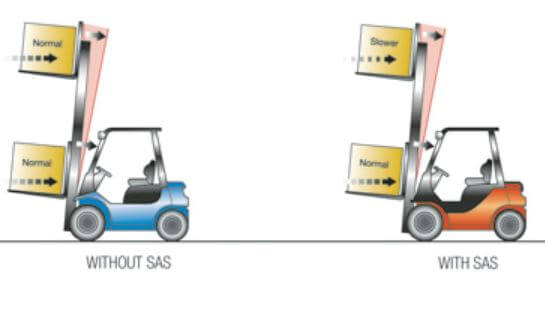3 Ways Toyota SAS Prevents Tipovers

Over 94,000 lift truck accidents are reported in the US every year. Operator training is essential to reducing that number but it isn’t enough.
Toyota decided that the best approach to preventing lift truck accidents is “one that combines the efforts of every person, business and organization involved” and decided take the lead role as a manufacturer. As a result they created the world’s first System of Active Stability™(SAS).
Derived from automotive technology, SAS is able to electronically monitor and control lift truck operations. When the SAS system detects instability, its advanced sensors simultaneously signal and engage the appropriate controller. The two key components of the system are the Active Control Rear Stabilizer and the Active Mast Function Controller. These features adds stability and help avoid accidents or injuries.
Lateral instability – tipping sideways
When lateral instability is detected, the Active Control Rear Stabilizer System instantly locks a hydraulic cylinder on the rear steer axle. That changes the lift truck’s stability footprint from triangular in shape to rectangular. The resulting increase in stability reduces the likelihood of a lateral overturn
When it senses instability, SAS instantly engages the Swing Lock Cylinder to stabilize the rear axle, creating the lateral stability needed to help reduce the risk of lateral tip-overs.
Longitudinal instability – tipping forward or back
The active mast function controller system uses the same patented technology to sense various factors that lead to potential longitudinal instability. When the SAS controller senses potential longitudinal instability, two systems are activated to help reduce the chances of forward or rearward tip-overs: forward tilt angle control and rear tilt speed control.
Forward Tilt Angle Control will sense load weight and mast height, then automatically override the operator’s manual control and limit forward tilt to decrease the chance of spilling a load or tipping the lift truck forward.
Rear Tilt Speed Control utilizes the same load and mast height sensors to govern the mast’s reverse tilt speed thereby decreasing the chances of spilling unsecured loads or tipping the lift truck backward.
This system is exclusive to the Toyota forklifts and not available from any other manufacturer.
To see these systems in action, check out these videos:
- SAS System (2min 24 sec)
- Active Control Rear Stabilizer (46 seconds)
- Active Mast Control Animation (59 seconds)
This is just one of the reasons readers of Modern Material Handing ranked Toyota the Safest Lift Truck in a recent survey. To experience this level of safety in your business, please give us a call.
